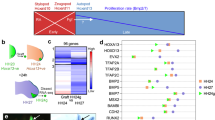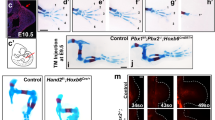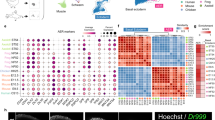Abstract
The ‘progress zone’ model provides a framework for understanding progressive development of the vertebrate limb1. This model holds that undifferentiated cells in a zone of fixed size at the distal tip of the limb bud (the progress zone) undergo a progressive change in positional information such that their specification is altered from more proximal to more distal fates. This positional change is thought to be driven by an internal clock that is kept active as long as the cells remain in the progress zone. However, owing to cell division, the most proximal of these cells are continually pushed outside the confines of the zone. As they exit, clock function ceases and cells become fixed with the positional value last attained while within the zone. In contrast to this model, our data suggest that the various limb segments are ‘specified’ early in limb development as distinct domains, with subsequent development involving expansion of these progenitor populations before differentiation. We also find, however, that the distal limb mesenchyme becomes progressively ‘determined’, that is, irreversibly fixed, to a progressively limited range of potential proximodistal fates.
This is a preview of subscription content, access via your institution
Access options
Subscribe to this journal
Receive 51 print issues and online access
$199.00 per year
only $3.90 per issue
Buy this article
- Purchase on Springer Link
- Instant access to full article PDF
Prices may be subject to local taxes which are calculated during checkout




Similar content being viewed by others
References
Summerbell, D., Lewis, J. H. & Wolpert, L. Positional information in chick limb morphogenesis. Nature 244, 492–496 (1973)
Rubin, L. & Saunders, J. W. Ectodermal-mesoderal interactions in the growth of limb buds in the chick embryo: constancy and temporal limits of ectodermal induction. Dev. Biol. 28, 94–112 (1972)
Saunders, J. W. The proximo-distal sequence of origin of the parts of the chick wing and the role of the ectoderm. J. Exp. Zool. 108, 363–403 (1948)
Summerbell, D. A quantitative analysis of the effect of excision of the AER from the chick limb-bud. J. Embryol. Exp. Morphol. 32, 651–660 (1974)
Rowe, D. A., Cairns, J. M. & Fallon, J. F. Spatial and temporal patterns of cell death in limb bud mesoderm after apical ectodermal ridge removal. Dev. Biol. 93, 83–91 (1982)
Niswander, L., Tickle, C., Vogel, A., Booth, I. & Martin, G. R. FGF-4 replaces the apical ectodermal ridge and directs outgrowth and patterning of the limb. Cell (1993)
Fallon, J. F. et al. FGF-2: apical ectodermal ridge growth signal for chick limb development. Science 264, 104–107 (1994)
Lewis, J. H. Fate maps and the pattern of cell division: a calculation for the chick wing bud. J. Embryol. Exp. Morphol. 33, 419–434 (1975)
Sun, X., Mariani, F. V. & Martin, G. R. Functions of FGF signalling from the apical ectodermal ridge in limb development. Nature 418, 501–509 (2002)
Vargesson, N., Clarke, J. D. W., Coles, V. K., Wolpert, L. & Tickle, C. Cell fate in the chick limb bud and relationship to gene expression. Development 124, 1909–1918 (1997)
Gibson-Brown, J. J. et al. Evidence of a role for T-box genes in the evolution of limb morphogenesis and the specification of forelimb/hindlimb identity. Mech. Dev. 56, 93–101 (1996)
Chapman, D. L. et al. Expression of the T-box family genes, Tbx1-Tbx5, during early mouse development. Dev. Dyn. 206, 379–390 (1996)
Yokouchi, Y. et al. Misexpression of Hoxa-13 induces cartilage homeotic transformation and changes cell adhesiveness in chick limb buds. Genes Dev. 9, 2509–2522 (1995)
Ros, M. A., Lyons, G. E., Mackem, S. & Fallon, J. F. Recombinant limbs as a model to study homeobox gene regulation during limb development. Dev. Biol. 166, 59–72 (1994)
Wada, N., Ohsugi, K., Yokouchi, Y., Kuroiwa, A. & Ide, H. Cell sorting and chondrogenesis aggregate formation in limb bud recombinants and in culture. Dev. Growth Diff. 35, 421–430 (1998)
Hardy, A. et al. Gene expression, polarising activity and skeletal patterning in reaggregated hind limb mesenchyme. Development 121, 4329–4337 (1995)
Crosby, G. M. & Fallon, J. F. Inhibitory effect on limb morphogenesis by cells of the polarizing zone coaggregated with pre- or postaxial wing bud mesoderm. Dev. Biol. 46, 28–39 (1975)
Frederick, J. M. & Fallon, J. F. The proportion and distribution of polarizing zone cells causing morphogenetic inhibition when coaggregated with anterior half wing mesoderm in recombinant limbs. J. Embryol. Exp. Morphol. 67, 13–25 (1982)
Piedra, M. E., Rivero, F. B., Fernandez-Teran, M. & Ros, M. A. Pattern formation and regulation of gene expressions in chick recombinant limbs. Mech. Dev. 90, 167–179 (2000)
Wolpert, L., Tickle, C. & Sampford, M. The effect of cell killing by X-irradiation on pattern formation in the chick limb. J. Embryol. Exp. Morphol. 50, 175–198 (1979)
Hornbruch, A. & Wolpert, L. Cell division in the early growth and morphogenesis of the chick limb. Nature 226, 764–766 (1970)
Logan, M. & Tabin, C. Targeted gene misexpression in chick limb buds using avian replication-competent retroviruses. Methods 14, 407–420 (1998)
Hamburger, V. & Hamilton, H. L. A series of normal stages in the development of the chick embryo. J. Morphol. 88, 49–92 (1951)
Kieny, M. & Pautou, M.-P. Proximo-distal pattern regulation in deficient avian limb buds. Wilhelm Roux Arch. 183, 177–191 (1977)
Gavrieli, Y., Sherman, Y. & Ben-Sasson, S. A. Identification of programmed cell death in situ via specific labeling of nuclear DNA fragmentation. J. Cell Biol. 119, 493–501 (1992)
Acknowledgements
We thank J. Fallon for discussions about cell death; C. Tickle, G. Martin and J. Saunders for critiques of our data; A. Brent, N. Davis, C. Hartmann, G. Kardon, G. Martin, R. Pearse and K. Vogan for critical reading of this manuscript; and G. Martin and X. Sun for sharing data before publication. This work was supported by a grant from the National Institutes of Health (C.J.T.) and a fellowship from the Leukemia and Lymphoma Society (A.T.D.). M.A.R. was funded by the Spanish Ministry of Education and Culture.
Author information
Authors and Affiliations
Corresponding author
Ethics declarations
Competing interests
The authors declare that they have no competing financial interests.
Rights and permissions
About this article
Cite this article
Dudley, A., Ros, M. & Tabin, C. A re-examination of proximodistal patterning during vertebrate limb development. Nature 418, 539–544 (2002). https://doi.org/10.1038/nature00945
Received:
Accepted:
Issue Date:
DOI: https://doi.org/10.1038/nature00945
This article is cited by
-
Fgf signalling triggers an intrinsic mesodermal timer that determines the duration of limb patterning
Nature Communications (2023)
-
Gene expression changes during the evolution of the tetrapod limb
Biologia Futura (2022)
-
Co-option of the cardiac transcription factor Nkx2.5 during development of the emu wing
Nature Communications (2017)
-
Regulation of testicular descent
Pediatric Surgery International (2015)
Comments
By submitting a comment you agree to abide by our Terms and Community Guidelines. If you find something abusive or that does not comply with our terms or guidelines please flag it as inappropriate.



